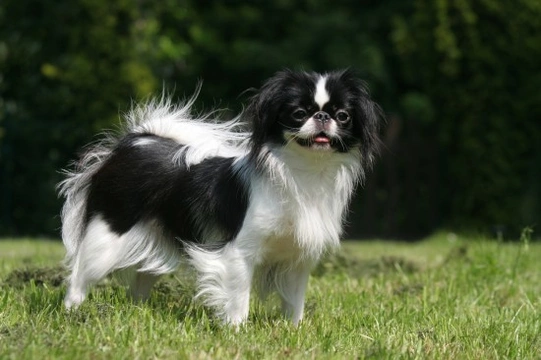
Japanese chin hereditary health and average longevity
The Japanese chin is sometimes also known as the Japanese spaniel, and is a small dog breed that falls within the toy dog category. Historically important in their home country of Japan, the Japanese chin was notably the dog of choice of the royalty and nobility of the country, with a long recorded history.
The Japanese chin stands up to 11” tall at the withers, and can weigh between 1.4-6.8kg, with most dogs of the breed falling around the middle of the range. They have large, wide eyes, feathered ears and a broad head, with a delicate body and fine legs.
While most breeds of dog have a double layered coat, the Japanese chin coat is only one layer, which can take up to two years to grow to its full length and density. They can be seen in a range of colours, including black and white, sable, and red and white. Some other colours are also possible across the breed, but not all of them are recognised by the breed standard.
If you have fallen for the charms of these fine, loving and delicate little dogs, you might be wondering if the Japanese chin makes a good choice of pet. If you are looking into ownership of the Japanese chin, this article will provide you with some information on the hereditary health and average longevity of the breed. Read on to learn more.
Japanese chin average longevity
The average lifespan of the Japanese chin is 10-12 years, with a reasonable amount of dogs of the breed living into their mid-teens or older. The average lifespan of the breed as a whole is considered to be within the normal range across the board for dogs of a similar height and build.
Genetic diversity
The coefficient of inbreeding statistic for the Japanese chin is 8.1%, which is slightly higher than the 6.25% or lower that is considered to be the ideal across the board for pedigree dog breeds. This indicates that Japanese chin breed lines are subjected to a reasonable degree of inbreeding in order to keep the breed viable in perpetuity. In order to raise the hereditary health of the breed as a whole, Japanese chin breeders are advised to only breed from dogs with a coefficient of inbreeding figure of below 8.1% where viable.
Conformation concerns
The Japanese chin is a small, delicate dog that is rather fragile, and care should be taken when exercising the dog to ensure that they do not become hurt or injured in high impact play.
The petite mouth of dogs of the breed can lead to poor dentition, including poorly formed teeth and adult teeth failing to descend from the gums properly, which should be checked regularly as the dog matures.
The short, narrow muzzle of the breed is classed as brachycephalic, which can lead to problems with breathing in overtyped dogs, and may mean that many dogs of the breed are prone to overheating in hot weather, as they are not able to pant enough to reduce their body temperature.
Health testing for the Japanese chin
The Japanese chin is not considered to have an elevated propensity to a wide range of hereditary health conditions, and the British Veterinary Association does not recommend any particular health tests or screening programmes prior to breeding. However, there is one condition that seems to be somewhat prevalent within the Japanese chin gene pool, which is gangliosidosis GM2, a lysosomal storage disorder that causes neurological disorders, and often proves fatal.
DNA testing can be performed prior to breeding, to identify a propensity to this condition within certain breed lines.
General health issues
The breed as a whole has also been identified as having risk factors for certain other hereditary health conditions, but not with a great enough recurrence rate that health testing for such conditions is widely advised. Some of these conditions include:
- Cataracts, most commonly in old age. Cataracts are generally operable.
- Patellar luxation, a condition of the kneecap. This condition arises when the ligaments and muscles that secure the kneecaps are overly weak, and unable to secure the kneecap in place properly. This can lead to dislocation of the kneecap, which may require surgical correction.
- Heart murmurs, due to degenerative changes to the mitral valve of the heart.
- Atlantoaxial subluxation of the cervical spine, a painful condition that affects the neck due to as spinal instability.
- Entropion of the eyelids, which leads to the eyelids turning inwards and rubbing on the eye, causing pain and soreness.
- A propensity to corneal ulcers of the eyes, due to their prominence within the face.
- Dry eye, a malformation of the tear ducts that causes the tear ducts to fail to provide sufficient lubrication to the eyes.
- An abnormality of the blood vessels in the eye, called persistent hyaloid artery, although this condition is relatively uncommon.



